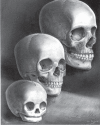An interview with Mark G. Hans
- PMID: 25162563
- PMCID: PMC4296620
- DOI: 10.1590/2176-9451.19.3.026-035.int
An interview with Mark G. Hans
Abstract
It is a great honor to conduct an interview with Professor Mark G. Hans, after following his outstanding work ahead of the Bolton-Brush Growth Study Center and the Department of Orthodontics at the prestigious Case Western Reserve School of Dental Medicine (CWRU) in Cleveland, Ohio. Born in Berea, Ohio, Professor Mark Hans attended Yale University in New Haven, CT, and earned his Bachelor of Science Degree in Chemistry. Upon graduation, Dr. Hans received his DDS and Masters Degree of Science in Dentistry with specialty certification in Orthodontics at Case Western Reserve University. During his education, Dr. Hans’ Master’s Thesis won the Harry Sicher Award for Best Research by an Orthodontic Student and being granted a Presidential Teaching Fellowship. As one of the youngest doctors ever certified by the American Board of Orthodontics, Dr. Hans continues to maintain his board certification. He has worked through academics on a variety of research interests, that includes the demographics of orthodontic practice, digital radiographic data, dental and craniofacial genetics, as obstructive sleep apnea syndrome, with selected publications in these fields. One of his noteworthy contributions to the orthodontic literature came along with Dr. Donald Enlow on the pages of “Essentials of Facial Growth”, being reference on the study of craniofacial growth and development. Dr. Mark Hans’s academic career is linked to CWRU, recognized as the renowned birthplace of research on craniofacial growth and development, where the classic Bolton-Brush Growth Study was historically set. Today, Dr. Hans is the Director of The Bolton-Brush Growth Study Center, performing, with great skill and dedication, the handling of the larger longitudinal sample of bone growth study. He is Associate Dean for Graduate Studies, Professor and Chairman of the Department of Orthodontics, working in clinical and theoretical activities with students of the Undergraduate Course from the School of Dental Medicine and residents in the Department of Orthodontics at CWRU. Part of his clinical practice at the university is devoted to the treatment of craniofacial anomalies and to special needs patients. Prof. Mark Hans has been wisely conducting the Joint Cephalometric Experts Group (JCEG) since 2008, held at the School of Dental Medicine (CWRU). He coordinates a team composed of American, Asian, Brazilian and European researchers and clinicians, working on the transition from 2D cephalometrics to 3D cone beam imaging as well as 3D models for diagnosis, treatment planning and assessment of orthodontic outcomes. Dr. Hans travels to different countries to give lectures on his fields of interest. Besides, he still maintains a clinical orthodontic practice at his private office. In every respect, Dr. Hans coordinates all activities with particular skill and performance. Married to Susan, they have two sons Thomas and Jack, and one daughter Sarah, and he enjoys playing jazz guitar for family and friends.
Figures



References
-
- Johnston LE. A simplified approach to prediction. Am J Orthod. 1975;67(3):253–257. - PubMed
-
- Greulich W, Pyle S. Radiographic atlas of skeletal development of the hand and wrist. 1. Redwood City: Stanford University Press; 1999.
Publication types
MeSH terms
LinkOut - more resources
Full Text Sources
Research Materials
